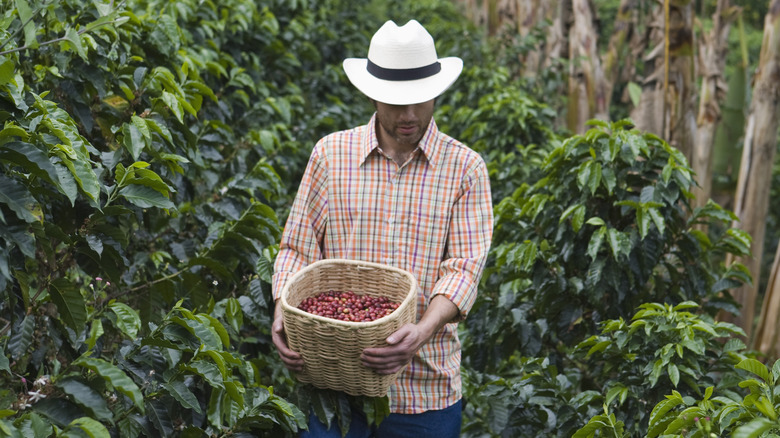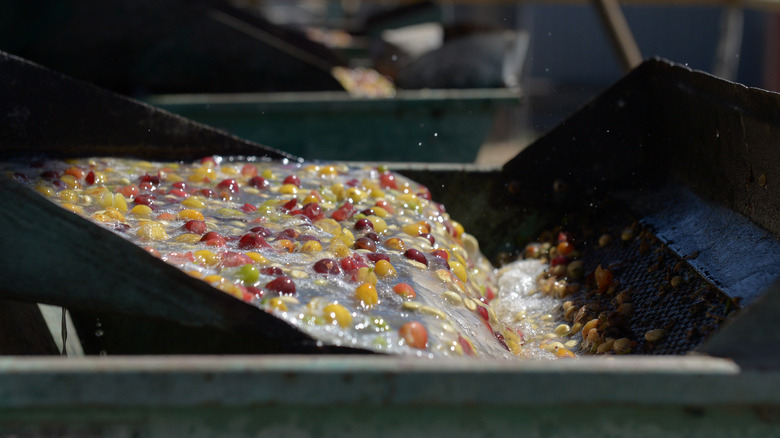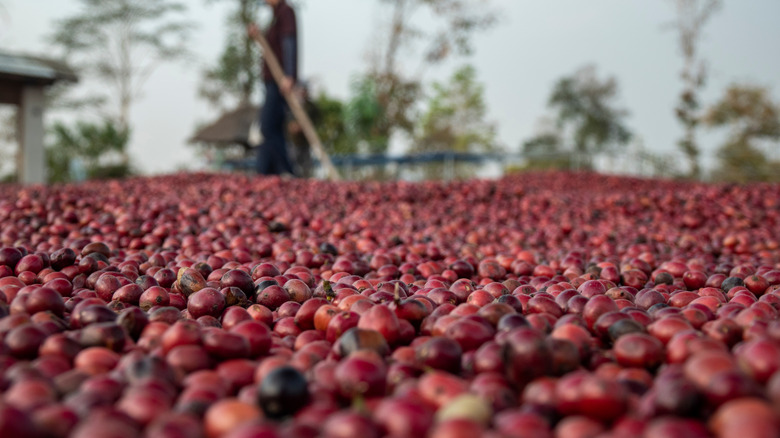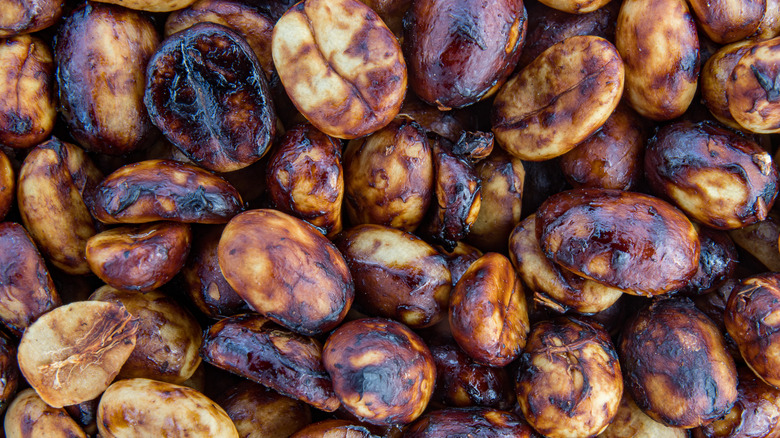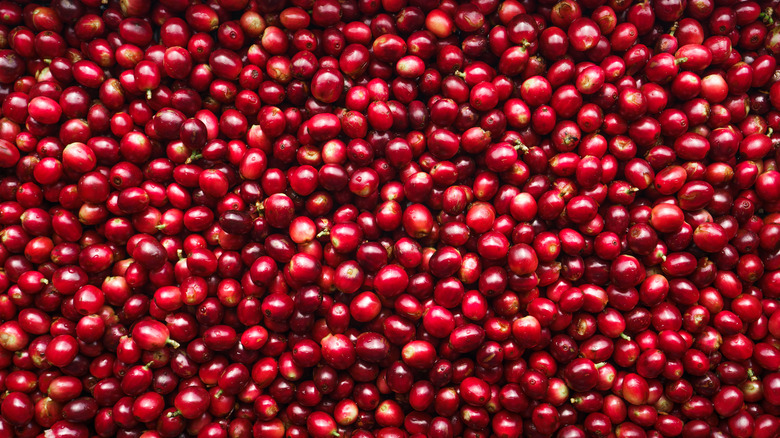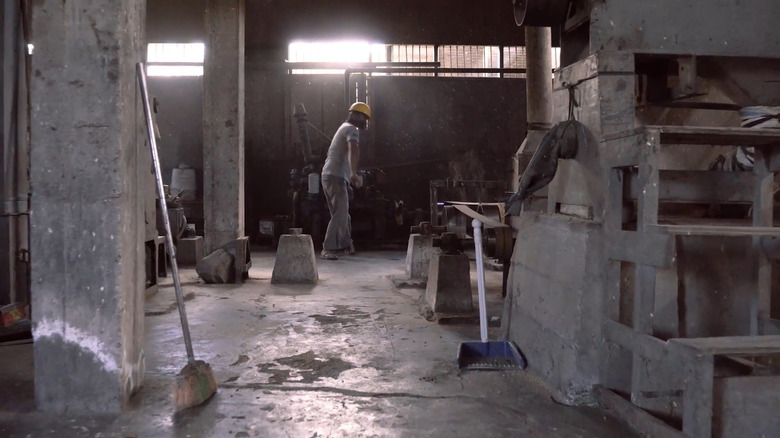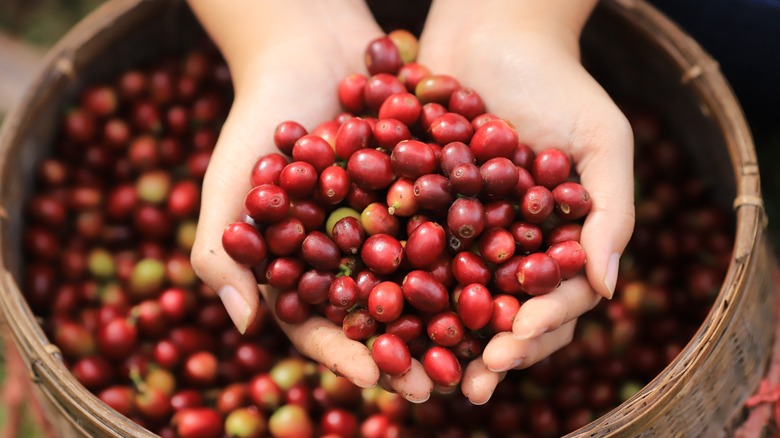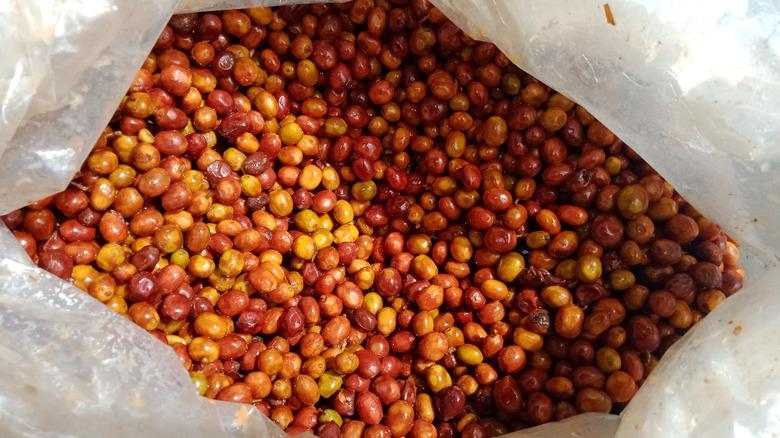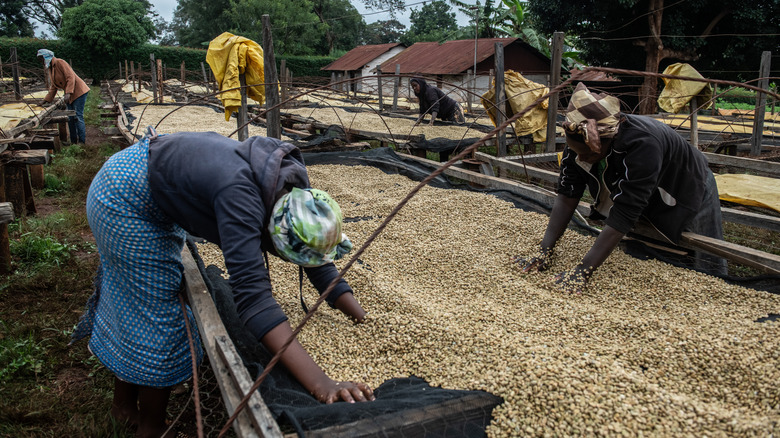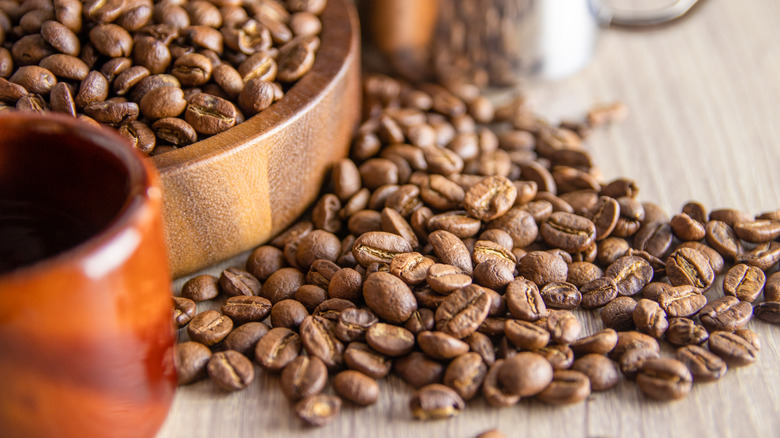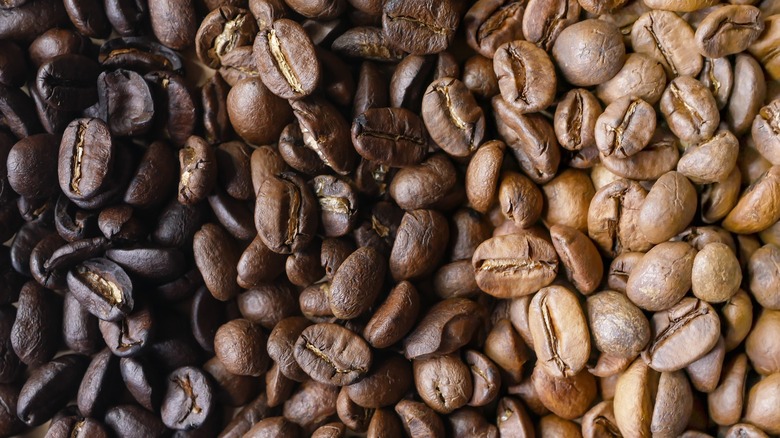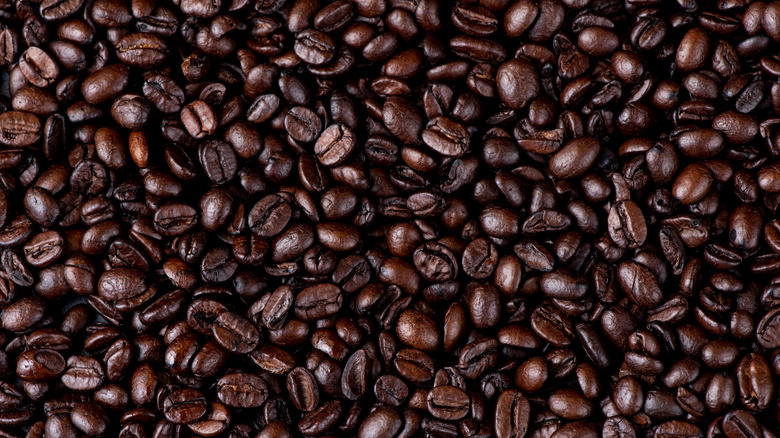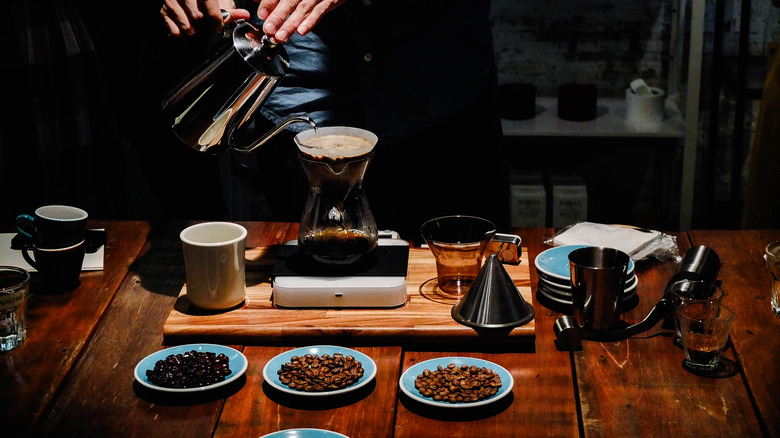The Ultimate Guide To Coffee Processing
Not long ago you would have been laughed out of town for suggesting that coffee was as complex as wine. But as Perfect Daily Grind reports, these roasted beans have been proven to carry more flavor compounds than even the finest of wines. Unsurprisingly, this complexity has led to an increasingly fussy — maybe even pretentious — culture developing around specialty coffee. While reminiscent of the wine industry, The Wall Street Journal highlights that as coffee leans into this prestigious image, wine is actually working to become more accessible. In other words, the two are following dramatically different trajectories.
Coffee's relatively new image as a complex drink surrounded by an even more complex culture is not doing it many favors (via The Telegraph). As such, producers and roasters are increasing their attempts to debunk specialty coffee's new aura of pretentiousness by providing clear and direct information. However, serious gaps in knowledge abound throughout coffee's consumer base, especially when it comes to how and why coffee is processed.
This article attempts to contribute to the demystification of specialty coffee by providing clear information on what the different coffee processes are, how they are performed, and what impact they have on the liquid that ends up in your cup.
Washed processing
All coffee beans are found inside a cherry-like fruit. Generally, different processing methods vary by removing none, some, or all of this fruit at different stages. One of the three most popular coffee processing methods is the washed process. For a coffee bean to be categorized as washed it must have had the cherry removed relatively quickly, including both the pulp and an inner layer known as the mucilage, as per Perfect Daily Grind. This process is explained by coffee industry legend, George Howell: "Traditionally, a washed coffee has employed water mainly to wash off mucilage after the coffee has been fermented over time with turbulent water. The mucilage comes off and then the coffee is dried," (via Perfect Daily Grind).
As the coffee bean dries without any of the fruit upon it, the resulting flavor of washed coffee beans is typically cleaner and more acidic than coffee that has been processed using alternative methods. Connoisseurs will often say the coffee tastes more of the bean itself (via K Agriculture) while the texture is typically lighter and more tea-like, as per The Irish Times. As washed coffee highlights the intrinsic flavor of the beans, it is a method most often used for high-quality coffee varieties like Arabica, which benefit from processes that allow the beans to "show off" their quality. The best suppliers of washed coffee are often found in Ethiopia and Yemen, as per K Agriculture.
Natural processing
If washed coffee is all about removing the fruit then natural processing advocates for the opposite. As Barista Magazine explains, naturally processing coffee entails the coffee cherries being laid out to dry in the sun for up to six weeks. During this time, the sugars from the cherry impart sweet, fruity flavors into the beans. Furthermore, a process of fermentation occurs as the fruit slowly begins to rot, lending an extra level of complexity to the bean including distinct funky notes. Too much fermentation can result in undrinkable coffee, so many producers take steps to limit the amount of fermentation that takes place. This can be through practices as simple as turning the fruit frequently, as per Sprudge. The same publication states that once the coffee is adequately dried the fruit is removed and the beans are ready for roasting.
While natural processed coffee used to have the reputation of being inferior to washed, the specialty coffee trend has definitely changed things. Now many consumers are searching for naturally processed coffees as they prefer the more diverse, earthier flavors and creamier textures associated with the method. Furthermore, the natural process requires drastically less water than the washed process, making it a more environmentally friendly option (via Perfect Daily Grind). The lack of expensive equipment also makes it an attractive option for communities that do not have access to expensive machinery or vast supplies of water, as per Barista Magazine.
Honey processing
Otherwise known as pulped natural, the honey process can be viewed as a method that stands between the washed and natural processes. As Barista Magazine reveals, the coffee that undergoes the honey process first has the majority of the cherry removed in a similar way to washed coffee. But crucially, the mucilage is left on the bean as the coffee first ferments and then dries. The bean is extremely sticky during the initial drying period, which is the reason why it's known as honey processing (via Perfect Daily Grind).
The same publication also notes that there are three types of honey processing: Yellow, red, and black. These simply refer to the color of the coffee bean as it dries, which in turn depends on the amount of mucilage that has remained intact. Yellow means coffee beans are one-quarter covered in mucilage, red is half covered, and black is totally covered. To put it simply, the greater the mucilage coverage, the more intense the flavors.
But what are these flavors? Well, as it borrows from washed and natural processes, you will not be surprised to learn that honey-processed coffee shares attributes with them both. Honey-processed coffees typically demonstrate the fruity, sweetness of natural coffee, combined with the clear acidity of washed coffee, as per Barista Magazine.
Anaerobic processing
While the previous processes have made up the three main ways coffee is processed, there are several newer and more experimental processing options available to coffee producers. Chief among these is anaerobic processing which, as Barista Magazine reveals, involves placing the freshly picked coffee — cherries and all — into a sealed vat. Thanks to the absence of oxygen the cherries impart unique flavors on the beans during this stage before being processed via washed, honey, or natural means.
Interestingly, it is not only time spent in anaerobic processing that affects coffee flavor but also the temperature, as Erwin Mierisch, a coffee producer from Nicaragua, explains: "In our experience, we've noticed that temperature (ambient and the mass of coffee) will play a big determinant in what kind of flavors are exhibited. In warmer fermentations, we find more intense notes like brown spices (cinnamon, clove, brown sugar being common), and in cooler fermentations (we ferment at 8-10C) we find a cleaner and vibrant acidity, with enhanced notes of the already found notes in the coffee," (via Sprudge).
As such, it is feasible to suggest that just about every coffee could suit anaerobic fermentation if processed properly. However, the cost and risks of wasted product that comes with experimenting with anaerobic processing will likely limit the commercial use of this very interesting method.
Wet hulled
Wet hulling is a process that was invented in, and is nearly exclusively used on, the islands of Indonesia, reports Bright Java. The reason why this collection of islands needs its own processing method is apparent to anyone who has visited Indonesia: Heavy and frequent rainfall. In fact, Bright Java states that the mixture of high humidity and rain makes it extremely difficult to dry their beans to the required level using more popular methods, especially in the short time periods that are necessary.
Perfect Daily Grind highlights that wet hulling begins in a similar fashion to washed processing. The cherry is removed along with mucilage. The coffee bean is then dried for up to three days until it reaches a moisture content of just under a quarter. Hulling, the removal of a parchment layer, then takes place before the beans are once again dried to reach between 12-13% water content.
The resulting coffee has an extremely heavy body complete with intense spicy flavors, as per Peet's. Consequently, Perfect Daily Grind suggests that wet-hulled coffee should only be used as part of a blend. Here it plays an important role, adding significant body while only taking up a small proportion of the total beans.
Lactic processing
Another experimental method of processing coffee is lactic processing. Market Lane Coffee notes that by manipulating the conditions under which fermentation takes place, producers can dictate which bacteria become dominant. By reducing oxygen levels and increasing non-iodized salt concentration (via Barista Hustle), producers can ensure lactic acid bacteria reign supreme. During fermentation, these bacteria produce compounds that directly contribute to a coffee's characteristics, as per Barista Magazine.
Tom Hopkinson, a staff member of Barista Hustle who tasted coffees produced in this manner for a Fermentation Training Camp in Colombia, explained what type of coffee results from this process: "The most noticeable difference was in the coffee's body. Compared to the control coffee, which was processed without a fermentation step, it had a much richer, creamier texture. It was also sweeter, with a pleasant, tangy acidity — and not a hint of salt," (via Barista Hustle).
Unfortunately, the same publication notes that this method does not actually guarantee that lactic acid bacteria will take hold as other microbes might survive and thrive as well. As such, the only way to be certain a coffee has been fully lactic processed is through inoculation with the bacteria. However, Barista Hustle notes that, at the moment, using this type of process is very expensive, limiting the amount of truly lactic processed coffee that is available on the market.
Carbonic maceration
A process that will be familiar to all the wine lovers out there, carbonic maceration is growing in stature when it comes to coffee. The process, which was directly borrowed from the winemaking industry by barista Saša Šestić (via MTPak), involves the coffee cherries being placed in carbon dioxide-rich environments, leading to the internal breakdown of the cherry. This imparts an array of extremely strong fruity notes, as per MTPak.
After experimenting with carbonic maceration for over half a decade, coffee producer Jamison Savage is still in awe of the process and the results it can yield. He told Barista Hustle: "I've found the CM process works well with about any variety. Interestingly, whatever is inherent in the grain will be magnified through this process. So, for example, if you're starting with a coffee known to be a highly floral, fruity coffee, as in the case of Geisha (If grown in proper terroir) those qualities will be magnified. So, essentially, whatever you are starting with will be amplified, for better or worse."
One sticking point when it comes to carbonic maceration is the amount of time the lengthy process can take. As MTPak highlights, it can be months before the coffee cherries have broken down sufficiently. And while the exclusivity and high price point of these coffees are sure to attract some, these same characteristics might limit carbonic maceration coffee's popularity around the globe.
Double ferment
In Kenya, coffee production and processing are tightly controlled by the state. Nearly all coffee produced in Kenya is processed via a unique method known in the industry as double ferment. According to Five Senses Coffee, this process is adapted from the washed process mentioned previously. The only difference between the two is that the coffee is fermented with mucilage on and once again when the bean has been completely cleaned. In theory, this should give the bean more opportunity to develop both the range and intensities of its flavors.
However, the autonomy the Kenyan authorities have over the country's coffee industry doesn't affect just the processing — it also causes reportedly negative consequences for workers. Kenyan farmers have been reported complaining that the system limits their earnings and leaves them vulnerable to abuse by the authorities, as per Perfect Daily Grind. Many have called for reform, voicing concerns that the current conditions in the industry are unsustainable.
Light roast
Once a coffee has been processed, it is shipped to a roastery. Here, roasters must use their knowledge of the raw coffee's characteristics to calculate which degree of roast would best suit it. While always a difficult job, roasting has become ever more complex as processing techniques produce increasingly interesting coffee, as Yiannis Taloumis, CEO of the coffee business Taf, highlights. "The modern processing techniques have really brought out the complexity in coffee; experimentally processed beans are very rich in flavor," he said. "But this is also the catch; if this complexity, this richness is not taken into consideration during roasting, it can lead to aggressive coffee flavors, and profiles that are not acceptable. This is why the roaster needs to experiment and find a balanced profile that will not be dominated by the intense fermentation of these coffees," (via Perfect Daily Grind).
There are three main choices when it comes to roasting coffee: Light, medium, and dark. Coffee Bros Roaster points out that light roasting — where beans are only heated to around 385 degrees Fahrenheit, known as the first crack (via Giesen) — allows the coffee to maintain more of its flavor than other roasts. Lightly roasted coffee also tends to have a thinner body than its more darkly roasted counterparts. All of this makes for a coffee-drinking experience that is significantly different from the bitter, syrupy diner-style coffee that many people are familiar with, and one that all coffee lovers would do well to try at least once.
Medium roast
The next logical step for roasting is the medium roast. This is a method where processed beans are roasted until after the first crack but before the second, which occurs around 435 degrees Fahrenheit (via Giesen). Coffee roasted to this degree offers the best of both extremes. It maintains the majority of the natural flavors present in lightly roasted coffee while also demonstrating the fuller body and added richness associated with darkly roasted coffee, as per Sagebrush Coffee.
Medium-roasted coffee has become a firm favorite among consumers, especially since the turn of the millennium. A fact that specialty coffee roaster owner, Nino Di Rienzo is very aware of: "We recommend drinking your coffee within three months of roasting. Also the style of roasting, we roast light to medium, which helps to showcase each coffee's individual flavors and taste profile ... Back then [2000] it was all about the Italian-style cafe culture, dark roasted beans with a bitter aftertaste. Which did not have a roast date or described where the coffee came from. Now people's taste and opinions towards coffee has changed," (via Eat Drink Guides). While some people may see medium roasts as the safe bet this does not change the fact that a good medium roast presents the best of both worlds. In other words, it is a fail-safe option that can result in extremely well-balanced and delicious cups of coffee.
Dark roast
Perfect Daily Grind reports that, historically, all coffee used to be dark roasted. That is, roasted until the end of, or after, the "second crack." This was in an effort to get a consistent product because all coffee, whether high or low quality, tastes very similar when darkly roasted. Tim Wendelboe, a coffee shop owner, even argues that coffees from different origins taste the same when roasted in this method: "A very dark roast means the coffee has almost lost its identity. You could take a Kenyan coffee or an Indonesian coffee and roast them very dark, and they would taste the same," (via Perfect Daily Grind).
This loss of nuance has led some in the coffee industry to turn up their nose at darkly roasted coffees. However, there are others who maintain that the dark roasting process still has a place — the coffees selected for it just need to be carefully considered. Kyle Ramage, co-owner of a coffee roastery, explained this notion to the same publication: "When you're getting into those roastier things, you need a lot of sweetness to make it even palatable. If we roast a not-super-sweet coffee pretty dark, it's just flat. It becomes one-dimensional."
That being said, dark roasts still have a loyal fan base among those who like coffee with no frills. What's more, a dark roast can also be a nice way to change up your coffee throughout the day without having to resort to alternative brewing methods.
Blending
The final step that coffee must take before being made available to the public is blending. It is important to note that not all coffees are blended. In fact, the specialty market seems to favor single-origin batches for reasons that Andra Vlaicu of the Specialty Coffee Association reveals: "The most important thing about single origin is its traceability, the fact that you know exactly where your coffee is from and that it's a specific coffee, not a blend. Usually of a higher quality, it's the acknowledgment that the coffee is from a particular farm located in a unique setting, whilst its flavor depicts its origin, possessing characteristics of that specific area where the particular coffee was grown," (via Perfect Daily Grind).
This doesn't automatically mean blends are worse. In fact, blended coffees can offer a broader range of flavors than unblended alternatives, simply for the fact that they can include a variety of beans from different locations around the globe. Additionally, blends are also extremely useful for maintaining consistency in flavor. This is because, with global coffee growing locations and farms going in and out of season over the whole year, the only way coffee with a consistent taste can be sold year-round is if different coffees are blended together in order to engineer the same flavor profile. This is a practice that is also prevalent when it comes to spirits such as whiskey, as per Chivas.
